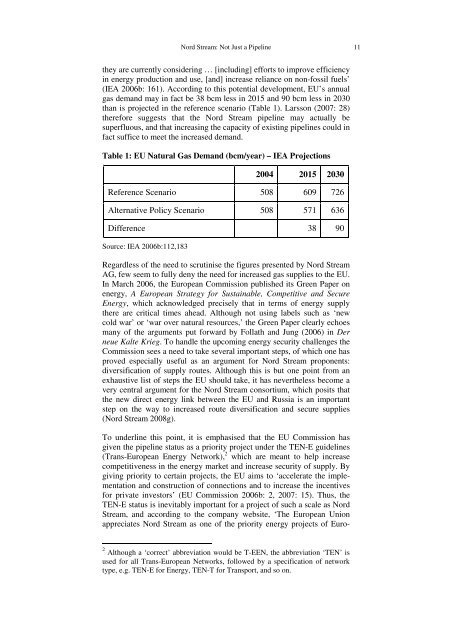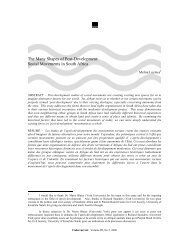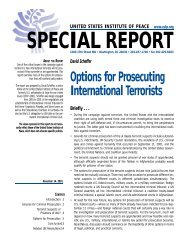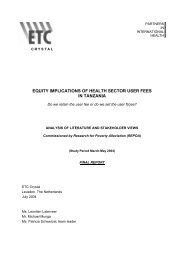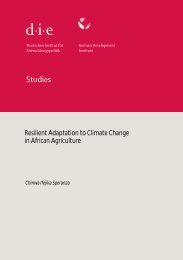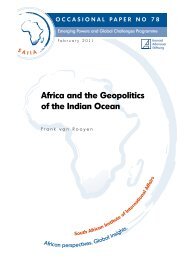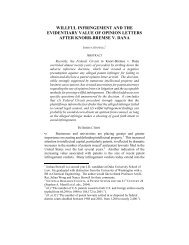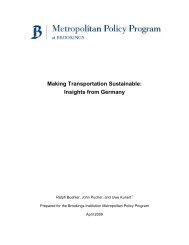Nord Stream: Not Just a Pipeline
Nord Stream: Not Just a Pipeline
Nord Stream: Not Just a Pipeline
Create successful ePaper yourself
Turn your PDF publications into a flip-book with our unique Google optimized e-Paper software.
<strong>Nord</strong> <strong>Stream</strong>: <strong>Not</strong> <strong>Just</strong> a <strong>Pipeline</strong> 11<br />
they are currently considering … [including] efforts to improve efficiency<br />
in energy production and use, [and] increase reliance on non-fossil fuels’<br />
(IEA 2006b: 161). According to this potential development, EU’s annual<br />
gas demand may in fact be 38 bcm less in 2015 and 90 bcm less in 2030<br />
than is projected in the reference scenario (Table 1). Larsson (2007: 28)<br />
therefore suggests that the <strong>Nord</strong> <strong>Stream</strong> pipeline may actually be<br />
superfluous, and that increasing the capacity of existing pipelines could in<br />
fact suffice to meet the increased demand.<br />
Table 1: EU Natural Gas Demand (bcm/year) – IEA Projections<br />
2004 2015 2030<br />
Reference Scenario 508 609 726<br />
Alternative Policy Scenario 508 571 636<br />
Difference 38 90<br />
Source: IEA 2006b:112,183<br />
Regardless of the need to scrutinise the figures presented by <strong>Nord</strong> <strong>Stream</strong><br />
AG, few seem to fully deny the need for increased gas supplies to the EU.<br />
In March 2006, the European Commission published its Green Paper on<br />
energy, A European Strategy for Sustainable, Competitive and Secure<br />
Energy, which acknowledged precisely that in terms of energy supply<br />
there are critical times ahead. Although not using labels such as ‘new<br />
cold war’ or ‘war over natural resources,’ the Green Paper clearly echoes<br />
many of the arguments put forward by Follath and Jung (2006) in Der<br />
neue Kalte Krieg. To handle the upcoming energy security challenges the<br />
Commission sees a need to take several important steps, of which one has<br />
proved especially useful as an argument for <strong>Nord</strong> <strong>Stream</strong> proponents:<br />
diversification of supply routes. Although this is but one point from an<br />
exhaustive list of steps the EU should take, it has nevertheless become a<br />
very central argument for the <strong>Nord</strong> <strong>Stream</strong> consortium, which posits that<br />
the new direct energy link between the EU and Russia is an important<br />
step on the way to increased route diversification and secure supplies<br />
(<strong>Nord</strong> <strong>Stream</strong> 2008g).<br />
To underline this point, it is emphasised that the EU Commission has<br />
given the pipeline status as a priority project under the TEN-E guidelines<br />
(Trans-European Energy Network), 2 which are meant to help increase<br />
competitiveness in the energy market and increase security of supply. By<br />
giving priority to certain projects, the EU aims to ‘accelerate the implementation<br />
and construction of connections and to increase the incentives<br />
for private investors’ (EU Commission 2006b: 2, 2007: 15). Thus, the<br />
TEN-E status is inevitably important for a project of such a scale as <strong>Nord</strong><br />
<strong>Stream</strong>, and according to the company website, ‘The European Union<br />
appreciates <strong>Nord</strong> <strong>Stream</strong> as one of the priority energy projects of Euro-<br />
2 Although a ‘correct’ abbreviation would be T-EEN, the abbreviation ‘TEN’ is<br />
used for all Trans-European Networks, followed by a specification of network<br />
type, e.g. TEN-E for Energy, TEN-T for Transport, and so on.


